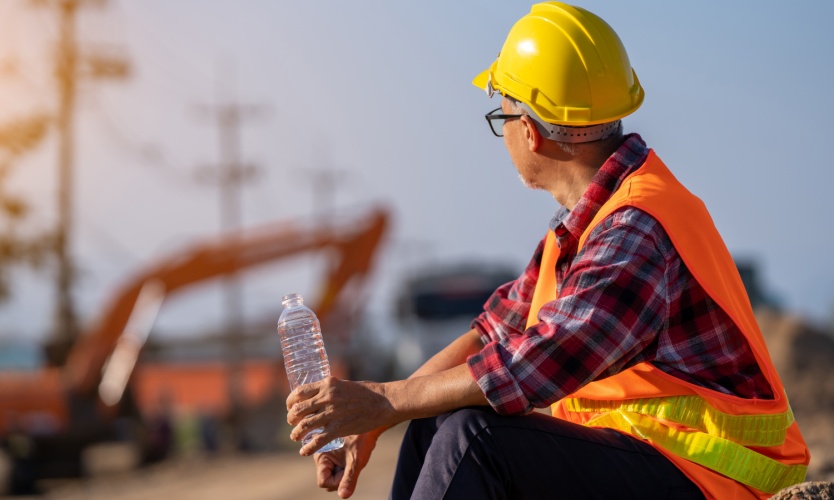Safety community says it is poised to move forward to protect workers from extreme heat
- September 26, 2025
- Posted by: Web workers
- Category: Workers Comp

Workplace safety experts say industries are moving forward with heat safety precautions despite the lack of a federal mandate forcing them to enact such measures.
Vendors at the National Safety Council Congress and Expo last week marketed such items as cooling “ice” vests and other personal protective equipment used to prevent overheating. Attendees crowded into sessions on heat safety and what heat stroke looks like.
The U.S. Occupational Safety and Health Administration is still working on a proposed standard for workforce heat safety, according to an agency spokesman at the conference, held Sept. 14 to 17 in Denver.
During a news conference, National Safety Council President Lorraine Martin addressed the various measures being implemented at both state and federal levels. Seven states have adopted occupational rules for heat safety as of mid-2025, and more are proposing policies.
Meanwhile, the federal government is navigating the range of opinions for and against its proposed heat standard after a series of public hearings over the summer, according to the OSHA spokesman. Safety professionals, meanwhile, lamented how long it takes for a standard to be implemented. Years, in most cases.
“Tune it out and do what’s best” for workers, Ms. Martin said, applauding what she sees as a heightened interest among employers seeking guidance. On managing a workforce dealing with high temperatures, Ms. Martin said, “You’ve got to know your environment. And there’s plenty of research on the human body and where it functions best. Make sure that the conditions you’re putting your workers in are within those guidelines.”
The expo floor at the conference is evidence that the industry is gearing up, Ms. Martin said.
“We just saw a helmet that had special aluminum painting on the top of it so that the head was 10 to 20 degrees cooler than what it would be outside,” she said. “Everybody’s saying, ‘OK, how can I help with this issue?,’ whether it’s garments, heat-resistant apparel, or other products. People in the distribution industry know this is something everyone’s working their way through, and there is technology that can help.”
Interest in heat-related illnesses and prevention is on the rise, Cecilia Kaufman, Storrs, Connecticut-based director of occupational safety with the Korey Stringer Institute at the University of Connecticut, told a packed room of safety professionals at the conference.
Research conducted at the Korey Stringer Institute shows that products emerging in the safety market, such as cooling vests and other garments that aid in keeping body temperatures lower, help with job productivity under high heat, with some showing a 15% increase in productivity when compared to no interventions, said Ms. Kaufman, who’s also president of the Heat Safety and Performance Coalition, part of the institute.
Industries are being more proactive when it comes to heat injury prevention, said Ms. Kaufman, who presents to employers regularly.
“We’ve moved away from reactive,” she said. “Most people are coming to these sessions asking questions. They say, ‘We don’t know if this is going to be implemented in my state or not, or we don’t know if this is going to be something we have to do, but we want to understand it.’”
Most of Ms. Kaufman’s advice centers on engineering and administrative controls, such as providing shade and water and providing opportunities for workers to acclimate when working in higher temperatures — many of the points proposed and implemented at both the state and federal levels.
“We can’t really necessarily eliminate heat,” she said. “So, this is about education and emergency preparedness.”
Aero Healthcare, which markets first aid kits for the workplace, had a “heat stress” emergency kit on display at the expo. Dallas-based business development manager Kirt Motta said the company’s OSHA-compliant first aid kits always contained materials, such as ice packs, to handle heat dangers. Still, the newer kits are more robust, containing such products as electrolyte drinks and tablets, thermometers, and thermal blankets.
“Our customers started reaching out to us and asking for this type of product,” he said. “Because of the demand, we started to take the next step to be able to provide everything in a single kit.”
Nearby on the expo floor was a display by Magid, a personal protective equipment company, featuring clothing, arm bands, neck gators and headgear that when wet can provide cooling relief. The uptick in interest in such heat-protective gear began almost five years ago, especially among those working in industries such as construction, said Alyssa Madsen, who works in the company’s marketing department in Chicago.
“There are the regulations in different states, so at this show and at past shows we’ve seen people gravitating towards products, saying, ‘We need to keep our workers safe from heat illness,’” she said. “Heat illnesses are 100% preventable, and I think people are starting to look at that.”
The American Society of Safety Professionals’ annual conference in Orlando, Florida, in July saw similar interest from both vendors and attendees, according to John Johnson, Overland Park, Kansas-based senior vice president and director of corporate environmental, health and safety at Black & Veatch, an engineering and construction company.
Mr. Johnson, who also chairs the ASSP committee that creates industry safety standards for construction and demolition operations, said the organization introduced heat rules for workers in 2024.
“We developed this because we saw this coming and we knew that we would have an opportunity to develop a standard a lot quicker than OSHA would,” he said. “Good employers will implement a heat illness prevention program similar to what we outlined in our standard because industries see the outcomes of not addressing that issue. Heat-related illnesses are very disruptive to the individual. They can kill people very, very quickly if not addressed.”



